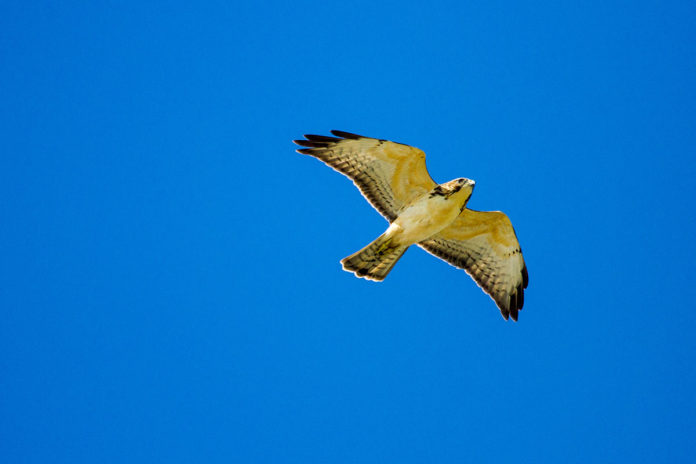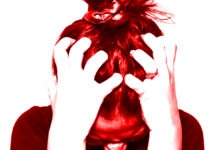I was pedaling past the sexton’s office at the cemetery when I heard the shriek. Like a just folded poker hand, I can’t really recall its exact details now. But it was high and piercing, and my first and only thought was: hawk.
It came from somewhere beyond the tree line, somewhere above the Harris School.
I stopped my bike and started to look around.
A short-tailed hawk popped up above all that green leafiness, turning a half circle in the air before disappearing again. Ah, I thought. Then a broad-winged hawk popped up, and did pretty much the same thing. Not so ah, I thought.
Birds of prey are not particularly good singers and they don’t have deep repertoires. Broad-wings tend to make these high, clear single-note vocalizations. Short-tailed hawks, which call much less frequently, tend to make these arcing, two note vocal slides, sounding kind of like a gray catbird if it was trying to not sound like a cat. (That last description may not make any sense outside the confines of my skull. But I’m sticking with it.)
The shriek had neither’s familiar ring.
As if cued by a backstage manager with a headset, clipboard and black turtleneck, the birds emerged into the open air again, the broad-wing first, then the short-tail, flying straight for a bit, then circling, the role of leader and chaser alternating between them.
The birds, which were about the same size, whirled above in a kind of obverse pas de deux, each the other’s opposite, down to the fact of the broad-wing being light plumed and the short-tail being dark plumed. They spun for a while in a thermal over the house where Carolyn Gorton Fuller’s bottle wall used to be, then slid off to spin for a while over the obelisque-marked plot of Los Martires de Cuba, then came back closer and spun above the green soldier with the oar that watches solemnly over the USS Maine plot.
In traditional notions of choreography this could maybe be seen as early moments of romantic entanglement, the two potential paramours circling one another as they work up to their inevitable coming together. Or it could have been seen as two friends out on a lark, enjoying each other’s company.
But a more realistic model would likely be seen in, say West Side Story, where the two adversaries in a knife fight would square off with an overly-refined balletic movement you would not necessarily expect from street ruffians. Or maybe that episode in the original Star Trek series where Kirk and Spock try to kill each other with those giant cheese knife-looking things in the Vulcan kal-if-fee ritual.
I was waiting for one to take a dive at the other, razor-sharp talons out. It was only a matter of time.
Birds of prey don’t really do the whole friendship thing. Or the whole colonial thing. Or the generally tolerate the presence of other birds of prey in their immediate presence thing. Other than mating and rearing young, they generally prefer to be alone.
This would be seemingly belied by the fact that we sometimes get kettles of hundreds of hawks moving together through the Keys. But that is generally by necessity. There are only so many favorable flightlines along a migration route, especially in a land-skint place like the Keys, and they’re basically traveling in the same subway train, riding the same elevator.
During migration I’ve seen 19 Peregrine falcons perched on a single radio tower. But they were spread out as much as possible, at all different levels, and each seemed intent on pretending the other 18 Peregrines didn’t exist.
Birds tend to get most aggressive over issues of territory during breeding season, when there are vulnerable nests and eggs or fledglings at stake. Things tend to be a little more relaxed in winter habitats, especially in Key West when there are enough chickens, pigeons, doves and other birds around that a hawk in good health is not going to starve.
You see birds of prey in the same airspace over Key West on a pretty regular basis, but these tend to be passing moments, like running into someone you’ve been avoiding at Fausto’s. Everybody tends to go their own way quickly.
But these two seemed to be following each other around. Or at least one was following the other and biding his time. I started to wonder, who was on whose turf?
I thought a little about local ospreys in the fall, how when the migrant ospreys flew too low, would come up and escort them to the edge of their territory, like an old-timey sheriff.
And then I started thinking about this one afternoon years ago at the Green Parrot, when a pretty large guy had over imbibed and was kind of getting out of control, and the staff decided to 86 him. John Vagnoni, the manager, came out to do it. And how the guy just seemed so huge and John seemed so… the opposite of huge. And the guy was angrily making his pretty incoherent case about how he was being wronged, how he was misunderstood, how he had rights. And Vagnoni just nodded and looked sympathetic, and took an easy step forward with his hands out at his sides and gently said, “Yeah, I know buddy. But you gotta go.” And how the big drunk guy took a step backwards and started pleading his case again, and John took another step forward and repeated, “Yeah, I know buddy. But you gotta go.”
This went on past the pinball machine, the pool table, the popcorn machine, and the cigarette machine, until the guy found himself out on the sidewalk, no longer with any standing, or impetus, to plead his case. Because he’d been moved out without really understanding how it happened.
Maybe this was what was going on with the hawks. One of them was being escorted out of the other’s territory so subtly and deftly that it was impossible to tell who was 86-ing who. Even after they slid out of the cemetery towards St. Mary Star of the Sea, and then caught a thermal, and rose so high up you couldn’t keep track of either one of them.





















